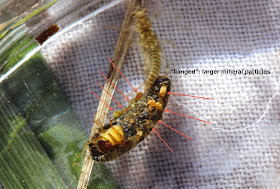Wednesday, December 31, 2014
An interesting morning at Buck Mt. Creek
I had hoped to get into the mountains today, but I didn't have time. So, a quick trip to Buck Mt. Creek -- where the water is still running high. I saw a lot of small winter stoneflies, but they're still not showing color (i.e. maturing) so I'll focus on other things.
__________________
Apatania incerta: common name, "little mountain case-makers". I've only seen them in three different streams: Buck Mt. Creek, the Doyles River, and the Rapidan River. Apataniidae, like Uenoidae, used to be considered a genus in the Limnephilidae family (northern case-makers), but is now a family all on its own.
This is the little larva that makes a "cornucopia-shaped" case with a hood at the top that completely covers the larva in the dorsal view,
though on occasion, you can see some or all of the legs.
Worth another look at Beaty's description. ("The Trichoptera of North Carolina," p. 85)
Genus Diagnosis [for Apatania]. Mesonotum with two plates; metanotal sa1 sclerites absent; arrangement of sa1 associated setae in a linear transverse row.
Case: composed of mineral particles and strongly curved, cornucopia-shaped; larger mineral particles laterally.
A. incerta -- larvae 6-9 mm; head dark brown to black; nota brownish-black; anterior metanotal plates replaced by row of about 20 setae.
We can see the shape of the case in the photos at the top of the page. For the "larger mineral particles laterally" -- i.e. a "flange" -- a couple of photos.
The color of the head -- "dark brown to black" -- can also be seen in our photos (also, legs are "yellow brown"). But for the nota, and the row of 20 setae that replaces the sa1 sclerites on the metanotum, best to use a microscope view.
We can actually count 10 setae on the left side of the metanotum. This is, by the way, a fairly intolerant larva. In the tolerance values assigned in North Carolina, the TV is 0.6.
_________________
Strophopteryx fasciata: one of our "large winter stoneflies". The largest nymph I found today liked to sit on the A. incerta case!
Strophopteryx nymphs are given a tolerance value of 3.3. I almost always find them in the very same streams in which I find the large winter stonefly, Taeniopteryx burksi/maura. This is the best I could do for a photo,
but it's sure a good match for Beaty's description ("The Plecoptera of North Carolina," p. 7): "abdominal terga yellow with uneven, dark brown transverse bands on anterior half of each tergite; median row of transverse dark dots on each tergite." Here's a close-up of those tergites, and also a look at the ventroapical plate the juts out from tergite 9.
You'll recall from the entry of 12/26, that the large winter stonefly T. atlanticum also has a ventroapical plate that is "broad apically" (Beaty, p. 7). By way of contrast, those on Strophopteryx nymphs are "concave laterally" (Beaty, p. 6). They look like this.
________________
Acroneuria lycorias. And more evidence to support my theory that A. lycorias and A. carolinensis can be distinguished (see the entry posted on 12/17).
Once again, this nymph lacked medial longitudinal markings on the terga, but had anal gills. On this one, the anal gills were gray, sparse, and hard to see.
A closer look at those gills.
A. carolinensis nymphs have medial markings and lack anal gills: A. lycorias nymphs are just the reverse. By the way, I ran this by Steven Beaty, and he thinks this might work out to be true. He finds the same correlation with the nymphs in his collection. Aha!
Hope to celebrate the New Year in the morning by exploring a very small stream in Sugar Hollow.
















Very good post
ReplyDeleteThis comment has been removed by a blog administrator.
Delete